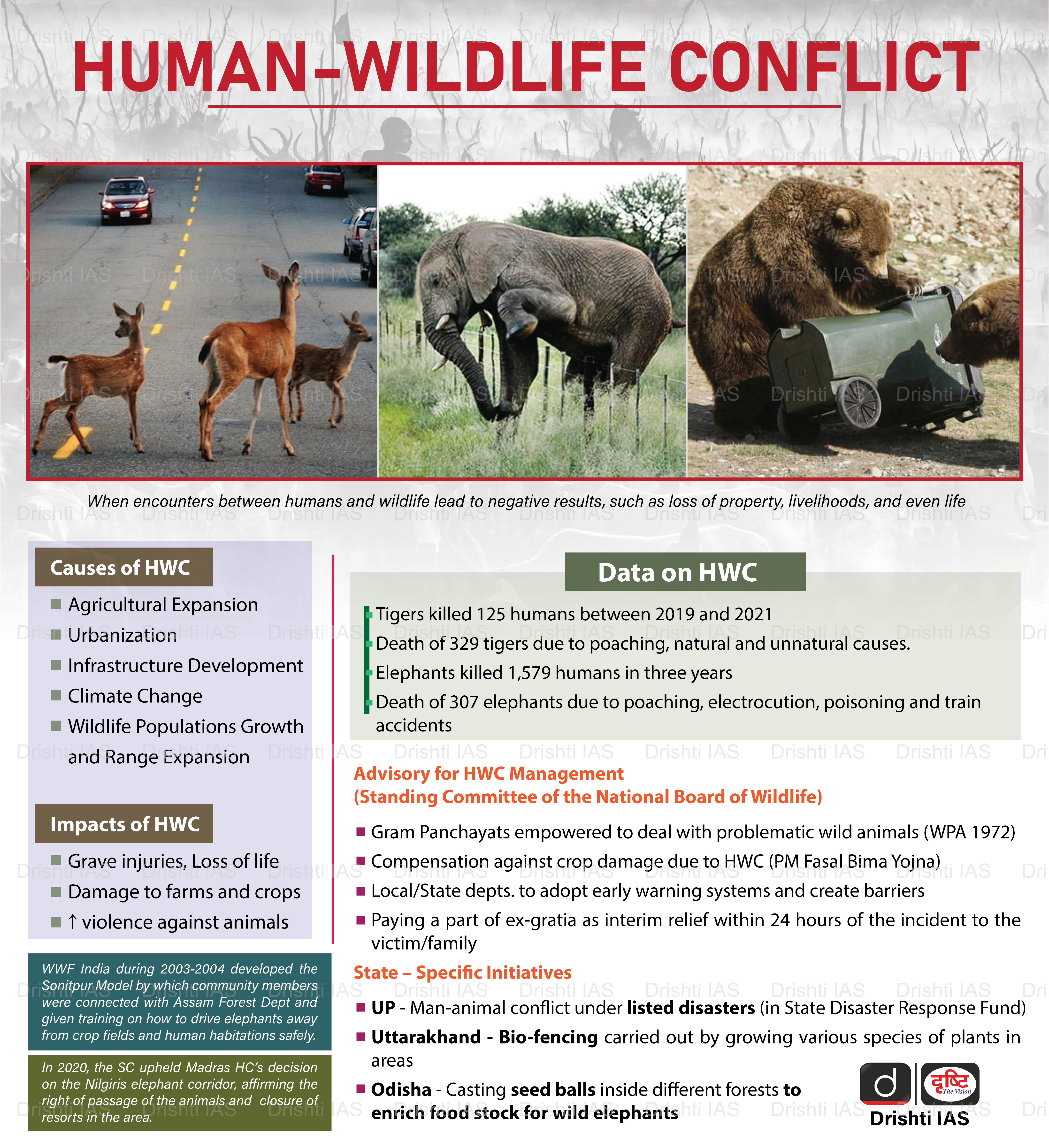Biodiversity & Environment
Conference on Human-Wildlife Conflict
- 04 Apr 2023
- 7 min read
For Prelims: Human-Wildlife Conflicts, International Union for Conservation of Nature, FAO, UNDP.
For mains: Issues of Human-Wildlife Conflict and Solutions.
Why in News?
Recently, the International Conference on Human-Wildlife Conflict and Coexistence was held in Oxford, the United Kingdom, which has brought hundreds of activists from 70 countries to discuss solutions to address Human-Wildlife Conflicts.
- The Conference was organized by the International Union for Conservation of Nature (IUCN), the Food and Agriculture Organization (FAO), the UN Development Programme and several other organizations together.
What does the Conference Aim at Achieving?
- Facilitate dialogue and peer-to-peer learning across sectors and actors on the topic for partnerships and collaboration across people and institutions working on human-wildlife conflict.
- Generate interdisciplinary and shared understanding of the latest insights, technologies, methods, ideas, and information from the field of human-wildlife conflict, coexistence and interactions.
- Mainstream human-wildlife conflict as one of the top global priorities in biodiversity conservation and the Sustainable Development Goals for the next decade, catalysing opportunities for working together on national, regional or global policies and initiatives.
- Identify and develop a collective way forward for addressing knowledge and implementation gaps for effective efforts to reduce and manage human-wildlife conflict.
What is the Need for this Conference?
- Human-wildlife conflicts across the world are a major challenge to conservation of species, making coexistence with nature difficult and hinders biodiversity protection.
- Conflict-related killing affects more than 75% of the world’s wild cat species, according to the United Nations Environment programme (UNEP).
- It will provide a platform for experts from the fields of “ecology, animal behaviour, psychology, law, conflict analysis, mediation, peacebuilding, international development, economics, anthropology and others, to understand human-wildlife conflict through various viewpoints, learn from each other, and build new links and collaborations.
- Effective management of human-wildlife interactions is prescribed in Target 4 of the Kunming-Montreal Global Biodiversity Framework agreed at the UN Biodiversity Conference in December 2022.
What is Human-Animal Conflict?
- About:
- Human-animal conflict refers to situations where human activities, such as agriculture, infrastructure development, or resource extraction, come into conflict with wild animals, leading to negative outcomes for both humans and animals.
- Implications:
- Economic Losses: Human-animal conflict can result in significant economic losses for people, especially farmers and livestock herders. Wild animals can destroy crops, damage infrastructure, and kill livestock, leading to financial hardship.
- Threats to Human Safety: Wild animals can pose a threat to human safety, especially in areas where people and wildlife coexist. Attacks by large predators such as lions, tigers, and bears can result in serious injury or death.
- Ecological Damage: Human-animal conflict can have a negative impact on the environment. For example, when humans kill predators, it can lead to an increase in prey populations, which can then cause ecological imbalances.
- Conservation Challenges: Human-animal conflict can also pose a challenge to conservation efforts, as it can lead to negative perceptions of wildlife and make it difficult to implement conservation measures.
- Psychological Impacts: Human-animal conflict can also have psychological impacts on people, especially those who have experienced attacks or property damage. It can lead to fear, anxiety, and trauma.
- Government Measures:
- The Wildlife Protection Act, 1972: This act provides the legal framework for the activities, Prohibition of hunting, Protection and management of wildlife habitats, Establishment of protected areas etc.
- The Biological Diversity Act, 2002: India is a part of the United Nations Convention on Biological Diversity. The provisions of the Biological Diversity Act are in addition to and not in derogation of the provisions in any other law relating to forests or wildlife.
- National Wildlife Action Plan (2002-2016): It focuses on strengthening and enhancing the protected area network, on the conservation of Endangered wildlife and their habitats, on controlling trade in wildlife products and on research, education, and training.
- Project Tiger: Project Tiger is a Centrally Sponsored Scheme of the Ministry of Environment, Forests and Climate Change (MoEFCC) launched in 1973. It provides havens for tigers in the country’s national parks.
- Project Elephant: It is a centrally sponsored scheme and was launched in February 1992 for the protection of elephants, their habitats and corridors.
UPSC Civil Services Examination Previous Year Question (PYQ)
Prelims
Q. Consider the following statements in respect of Trade Related Analysis of Fauna and Flora in Commerce (TRAFFIC): (2017)
- TRAFFIC is a bureau under United Nations Environment Programme (UNEP).
- The mission of TRAFFIC is to ensure that trade in wild plants and animals is not a threat to the conservation of nature.
Which of the above statements is/are correct?
(a) 1 only
(b) 2 only
(c) Both 1 and 2
(d) Neither 1 nor 2
Ans: (b)
Exp:
- Trade Related Analysis of Fauna and Flora in Commerce (TRAFFIC), the wildlife trade monitoring network, is a joint program of World Wide Fund for Nature (WWF) and IUCN – the International Union for Conservation of Nature. It was founded in 1976. It is not a bureau under UNEP. Hence, statement 1 is not correct.
- TRAFFIC works to ensure that trade in wild plants and animals is not a threat to the conservation of nature. Hence, statement 2 is correct.
- TRAFFIC focuses on leveraging resources, expertise and awareness of the latest globally urgent species trade issues such as tiger parts, elephant ivory and rhino horn. Large scale commercial trade in commodities like timber and fisheries products is also addressed and linked to work on developing rapid results and policy improvements. Therefore, option (b) is the correct answer.







